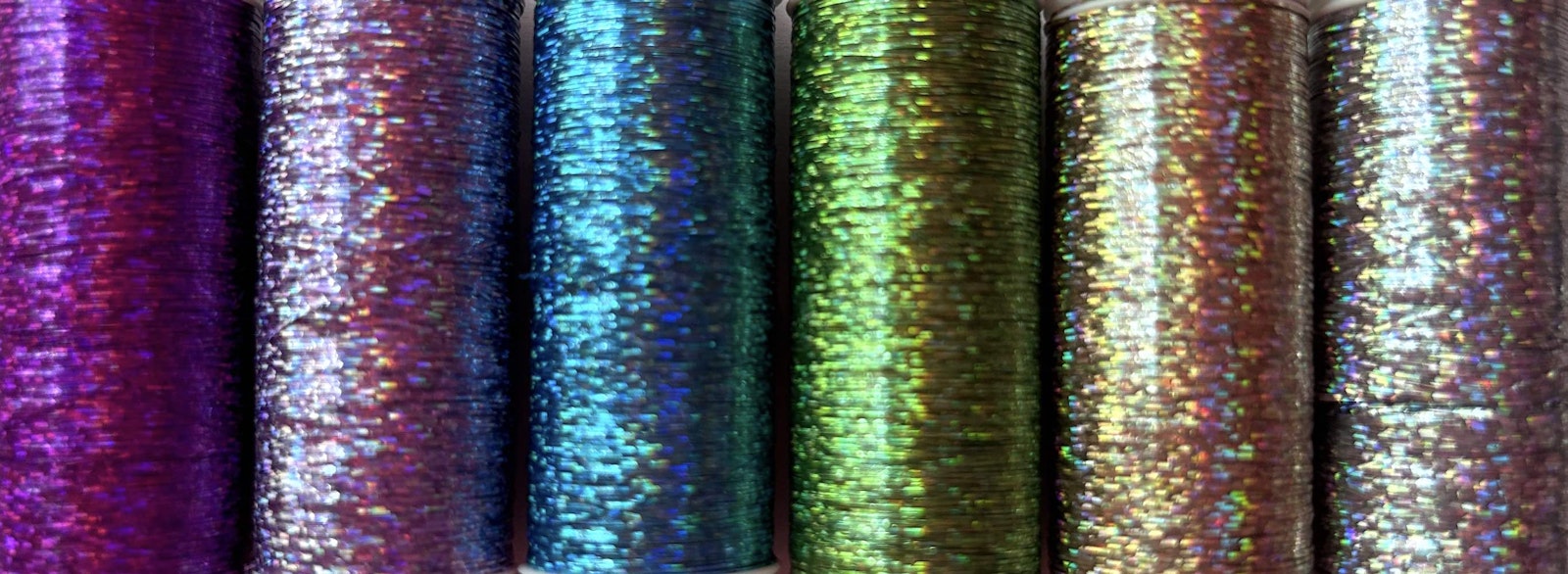In my experiments with tablet weaving, I’ve started playing around with iridescent filaments. My inspiration came from the incredible inkle weaver, Jeannine Glaves, whom I was lucky enough to sit next to during a tablet-weaving class at Weave Together. For her bands, she brought not only the required 10/2 cotton, but also a couple of small spools of beautiful sparkly sewing filament. She used the filament alongside her yarn, winding and threading the two as one. The result was subtly sparkly shoelaces that I could not help but ooh and aah over.
As a sucker for anything glittery or shiny, I knew I needed to try this technique for myself once I became more comfortable with the basics of bandweaving. I went to my local sewing store and bought a nice selection of filaments.
For my first experiment, I designed a dark- and light-pink band and paired a dark pink iridescent filament alongside the dark pink pattern threads. As I went to wind and thread my project, I realized I had a small problem. The pattern cards required 2 threads of dark pink, and while I had two balls of pink thread, I had only one spool of filament—and somehow I knew the filament would not play nice if I tried to unwind and rewind onto a secondary spool or bobbin.
 Christina’s first experiment in tablet weaving with iridescent filaments alongside the dark pink thread and filament.
Christina’s first experiment in tablet weaving with iridescent filaments alongside the dark pink thread and filament.
I ended up pairing only one dark pink thread with the filament, but the results were still incredible. The filament blends in perfectly with the yarn, creating a subtle shine that contrasts beautifully with the light pink. It’s not an in-your-face sparkle but one that invites a closer look. Given how much it shimmers with only one thread of filament per tablet, it makes me wonder how much I could up the sparkle by investing in a second spool.
 A close up of the pink band.
A close up of the pink band.
For my next experiment, I wanted to try using filament with two of the pattern thread colors. I designed fabric for a dog collar using two shades of blue with black outlines. Unfortunately, I could find only one shade of blue filament. I paired that light blue filament with a light blue thread, then chose a sort of silvery filament to pair with a darker blue. I was curious how the silver would react with the blue.
 The blue band next to both shades of blue thread and both filaments.
The blue band next to both shades of blue thread and both filaments.
This experiment ended up less sucessful than the first. The silver completely overwhelms the dark blue. It’s hard to tell in the photos, but in person it's so obvious, it distracts from everything else and negates the filament used with the light blue thread. It’s not bad—but it’s not what I wanted. (Fortunately, my dog Isla, the intended recipient of the collar, does not seem to mind.)
 Close up of the blue band.
Close up of the blue band.
So, what lessons have I learned? First, you don’t need to use filament with every thread in your card to create a sparkly band. Even pairing 25 percent of the threads with a filament will give you a beautiful sparkle. Second, unless you want the filament to stand out more than the actual threads, pair the filament with a similar color. Finally, when winding and threading the cards, keep the filament spool separated from the thread put-up, preferably in a container or on a spool holder. The filament tangles easily, but as long as you keep it separated, you’ll be fine.
As for me, I plan to buy a few more spools of filament and try some more experiments. Of course, whatever I learn, I’ll make sure to share it here.
Happy Weaving,
Christina

